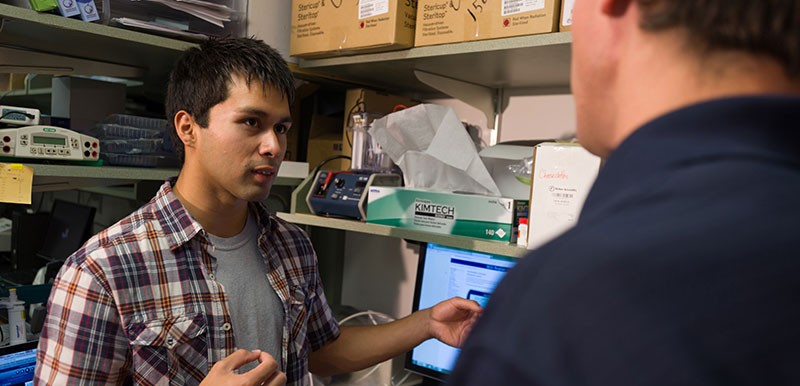
In this file photo from 2012, Cris Carillo, a California State University Monterey Bay student, talks with CSU Health and Exercise professor Adam Chicco during Carillo’s Research Experience for Undergraduates (REU). The newly launched Bridges to the Baccalaureate program will bring more REU students to CSU’s campus.
A new, collaborative program between Colorado State University and Front Range Community College will offer support and opportunities for students interested in science and hoping to transfer from Front Range to CSU.
The National Institutes of Health-supported program is called Bridges to the Baccalaureate. CSU’s “B2B” program, headed by Professor of Psychology Ernie Chavez, has received $1.2 million over the next five years.
Aligned priorities
B2B’s chief aims align closely with a well-established CSU program called CO-AMP (Colorado Louis Stokes Alliance for Minority Participation), which Chavez also leads. CO-AMP is a National Science Foundation program involving community colleges and four-year institutions statewide, and it supports underrepresented minority students in STEM (science, technology, engineering or math). Chavez hopes B2B, while serving a similar but expanded population, will open up even more doors for this targeted group.
The B2B program broadens the scope of students being reached; it will include underrepresented minority students as well as first-generation college goers, and Pell Grant recipients. It will also target students studying a broader array of sciences than the NSF-funded CO-AMP grant supports, welcoming students who are pre-vet or pre-med, or are studying biomedical, social or behavioral sciences.
Research experience for undergrads
A keystone of B2B will be a Research Experience for Undergraduates (REU) specifically targeting Front Range Community College students hoping to transfer to CSU.
“Front Range is our closest and largest two-year feeder school, and we had been looking at ways to enhance the work of CO-AMP,” Chavez said. “This grant allows us to reach different majors, as well as a two-year school that is not currently a member of our CO-AMP consortium.”
REU programs, which bring undergraduate students to campuses to work in research labs for 10 weeks over a summer, are typically very competitive. There’s ample evidence that involvement in research programs increases the likelihood of students remaining in, and graduating from, STEM fields, Chavez said.
Lifting past barriers to success
Part of B2B will also lift past barriers to transfer students’ success – specifically, a course in life sciences and a research methods course that were not available at Front Range and created a logjam with respect to junior and senior courses. CSU instructors will work with Front Range to develop and offer these courses at the community college, hopefully increasing student success so they’re better prepared to transfer.
Finally, a key advisor has been hired at Front Range, supported by the grant, to develop relationships with advisors at CSU to help with transitioning Front Range students.
“Community college students can be nervous about transferring to a large university,” said Heidi Smith, a faculty member in microbiology at Front Range, and the college’s lead for B2B. “This program will create a strong culture of transfer to address their concerns. We will start them off to CSU well-established in their degree program. Strong connections between faculty at both institutions will create a better transition. And engaging community college students in university research before they transfer is an incredible and unique opportunity.”
Chavez said he hopes the B2B program will continue closing an achievement gap that persists between minority and non-minority students, as well as increasing the quality and quantity of Front Range students transferring to CSU.
“Fifty percent of underrepresented students in higher education in the state of Colorado are in community colleges,” Chavez said. “If we don’t consider or look at the transfer and transition from two- to four-year institutions, we’re losing a large number of students we’re supposed to be helping.”